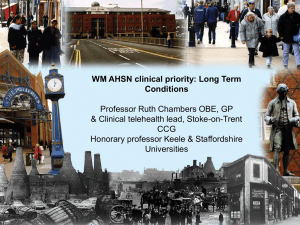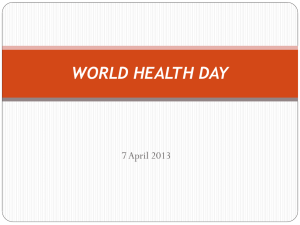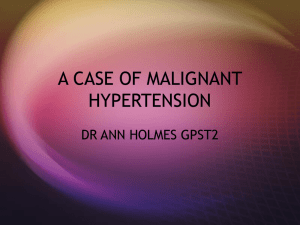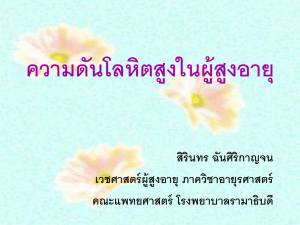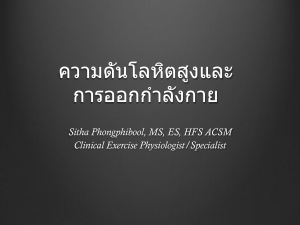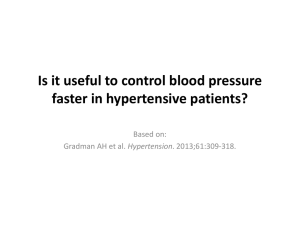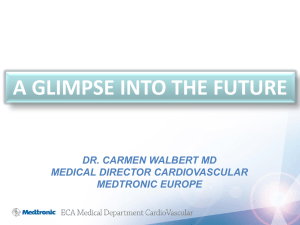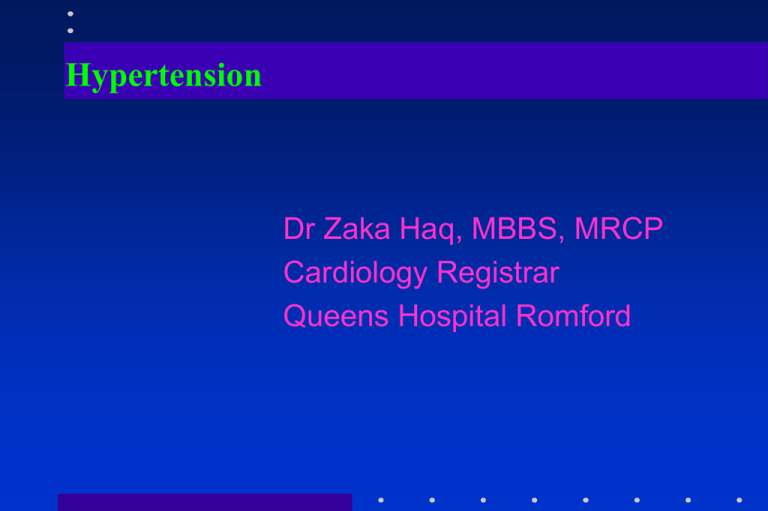
Hypertension
Dr Zaka Haq, MBBS, MRCP
Cardiology Registrar
Queens Hospital Romford
Hypertension
Prevalence (UK)
Challenges
NICE
Primary Care
Beta Blockers
Hypertension-Overview
Hypertension itself-Introduction
Types
Classification
Risk Factors
Sequels
Hypertension in special circumstances
Management
Follow Up
Guidelines
Referral to Secondary care
Hypertension, Introduction.
Hypertension is one of the most important preventable
causes of premature morbidity and mortality in the UK.
Hypertension is a major risk factor for stroke (ischemic
and haemorrhagic), myocardial infarction, heart
failure, chronic kidney disease, cognitive decline and
premature death. Untreated hypertension may result in
vascular and renal damage that can culminate in a
treatment-resistant state.
The risk associated with increasing blood pressure is
continuous, with each 2 mmHg rise in systolic blood
pressure associated with a 7% increased risk of
mortality from ischemic heart disease and a 10%
increased risk of mortality from stroke.
Hypertension, Introduction.
Diastolic pressure is more commonly elevated in
younger people. With ageing, systolic hypertension
becomes a more significant problem.
The clinical management of hypertension is one of the
most common 22 interventions in primary care,
accounting for approximately £1 billion in drug costs
alone in 2006.
Hypertension is often symptom less, so screening is
vital - before damage is done. Many surveys continue
to show that hypertension remains under diagnosed,
undertreated and poorly controlled in the UK
Hypertension, Introduction
In many countries, 50% of the population older
than 60 years has hypertension. Overall,
approximately 20% of the world’s adults are
estimated to have hypertension.
UK, 1 in every 4th person has Hypertension and
this increases to 1 in every second person aged
over 60.
Types of hypertension
Essential hypertension (Primary)
90%
No underlying cause
Secondary hypertension
5%
Underlying cause
Causes of Secondary Hypertension
Renal disease
Approximately 75% are from intrinsic renal disease:
glomerulonephritis, polyarteritis nodosa, systemic sclerosis,
chronic pyelonephritis, or polycystic kidneys.
Approximately 25% are due to Reno vascular disease - most
frequently atheromatous (e.g. elderly cigarette smokers with
peripheral vascular disease) or fibromuscular dysplasia (more
common in younger females).
Endocrine disease
Cushing’s syndrome, Conn's syndrome, pheochromocytoma,
acromegaly, Hyperparathyroidism
Others
Coarctation, Preeclampsia, Drugs and toxins, e.g. alcohol,
cocaine, ciclosporin, tacrolimus, erythropoietin, adrenergic
medications, decongestants containing ephedrine and herbal
remedies containing liquorice
Definitions and Classifications of BP Levels
Category*
Optimal
Normal
High-normal
Grade 1 hypertension (mild)
Grade 2 hypertension (moderate)
Grade 3 hypertension (severe)
ISH
Reading to Remember
SBP
(mm Hg)
< 120
< 130
130-139
140-159
160-179
> 180
> 140
140
DBP
(mm Hg)
< 80
< 85
85-89
90-99
100-109
> 110
< 90
90
WHO-ISH Guidelines Subcommittee J Hypertens 1999; 17:151
Hypertension: Predisposing factors
Age > 60 years
Sex (men and postmenopausal women)
Family history of cardiovascular disease
Smoking
High cholesterol diet
Co-existing disorders such as diabetes, obesity and
hyperlipidaemia
High intake of alcohol
Sedentary life style
Remember all these are predisposing factors for HTN
but they all including HTN are risk factors for
Cardiovascular disease.
Diseases Attributable to Hypertension
Gangrene of the
Lower Extremities
Heart
Failure
Left Ventricular
Hypertrophy Myocardial
Infarction
Hypertensive
Encephalopathy
Aortic
Aneurysm
HYPERTENSION
Coronary Heart
Disease
Blindness
Chronic
Kidney
Failure
Stroke
Cerebral
Preeclampsia/ Hemorrhage
Eclampsia
Adapted from Dustan HP et al. Arch Intern Med. 1996; 156: 1926-1935
Hypertension in special circumstances
HTN in Young-Causes
HTN and Pregnancy-Cautions
HTN and Diabetes - Proteinurea
HTN and Renal Failure – vice versa
Hypertensive Emergencies – urgency,
Emergency
Management of hypertension: the issues
Measurement
Classification
Investigations
Risk assessment
Non-pharmacological measures
Treatment thresholds
- 1st line
- sequencing
- beyond BP
Treatment targets
Concomitant therapy
Diagnosis and Measurement- 2011
If the first and second blood pressure measurements
taken during consultation are 140/90 mmHg or higher,
offer 24-hour ambulatory blood pressure monitoring
(ABPM) to confirm the diagnosis of hypertension.
[new 2011]
When using ABPM to confirm a diagnosis of
hypertension, ensure that:
Blood pressure is measured for a total of 24 hours.
At least two measurements per hour are taken during
the day (08:00 to 22:00).
At least one measurement per hour is taken during the
night (22:00 to 08:00).
Use the average daytime blood pressure measurement,
[new 2011]
Diagnosis and Measurement- 2011
When using home blood pressure monitoring (HBPM)
to confirm a diagnosis of hypertension, ensure that:
For each blood pressure measurement, two consecutive
measurements are taken, at least 1 minute apart and
with the person seated.
Blood pressure measurements are taken twice daily,
ideally in the morning and evening.
Blood pressure measurement continues for at least 4
days, ideally for 7 days.
Discard the measurements taken on the first day and
use the average value of all the remaining
measurements to confirm a diagnosis of HTN-2011
Potential indications for the use of ambulatory blood
pressure monitoring
•
Unusual variability
•
Possible white coat hypertension
•
Informing equivocal treatment decisions
•
Evaluation of nocturnal hypertension
•
Evaluation of drug-resistant hypertension
•
Determining the efficacy of drug treatment over 24 hours
•
Diagnoses and treatment of hypertension in pregnancy
•
Evaluation of symptomatic hypotension
Why Home or ABPM?
2004 Guideline recommended that BP should not be
diagnosed and treated based on one clinic BP
measurement
Majority will need repeated clinic visits to confirm or
refute the diagnosis
Inaccurate clinic measurements may weaken the
relationship between BP and CVD risk
People who do not have sustained BP may be wrongly
diagnosed and commenced on treatment with risk of
side effects and unnecessary diagnosis and anxiety and
cost.
Equipment
Training
Servicing
Investigations
Urine
Biochemistry
Blood Glucose
Lipid Profile
Electrocardiogram, CXR
USG-KUB, Urinary catecholamine, TSH, CXR,
ECHO, urinary free cortisol,
Specialist investigations
Life Style Modifications.
Maintain normal weight for adults (BMI 20-25 kg/m2)
Reduce salt intake to <100 mmol /day (<6g NaCl or
<2.4g Na+/day)
Limit alcohol consumption to <3 units/day for men and
<2 units/day for women
Engage in regular aerobic physical exercise (brisk
walking rather than weightlifting) for >30 min per day
Consume at least five portions/day of fresh fruit and
vegetables
Reduce the intake of total and saturated fat
STOP SMOKING
Next
Initiating and monitoring antihypertensive
drug treatment, including blood pressure
targets
Drug therapy for hypertension
Class of drug
Example
Initiating dose
Usual
maintenance dose
Hydrochlorothiazide
12.5 mg o.d.
12.5-25 mg o.d.
Atenolol
25-50 mg o.d.
50-100 mg o.d.
Calcium
channel
blockers
Amlodipine
2.5-5 mg o.d.
5-10 mg o.d.
-blockers
Doxazosin
1 mg o.d.
1-8 mg o.d.
ACE- inhibitors
Lisinopril
2.5-5 mg o.d.
5-20 mg o.d.
Angiotensin II
receptor blockers
Centrally Acting
Losartan
25-50 mg o.d.
50-100 mg o.d.
Diuretics
-blockers
Methyledopa
Hydralazine
Antihypertensive therapy:
Side-effects and Contraindications
Class of drugs
Main side-effects
Contraindications/
Special Precautions
Diuretics
Electrolyte imbalance,
(e.g. Hydrochloro- total and LDL cholesterol
thiazide)
levels, HDL cholesterol
levels, glucose levels,
uric acid levels
Hypersensitivity, Anuria
-blockers
(e.g. Atenolol)
Hypersensitivity,
Bradycardia, Conduction
disturbances, Diabetes,
Asthma, Severe cardiac
failure
Impotence, Bradycardia,
Fatigue
Antihypertensive therapy: Side-effects and Contraindications (Contd.)
Class of drug
Main side-effects
Contraindications/ Special
Precautions
Calcium channel blockers
(e.g. Amlodipine,
Diltiazem)
Pedal edema, Headache
Non-dihydropyridine
CCBs (e.g diltiazem)–
Hypersensitivity,
Bradycardia, Conduction
disturbances, Congestive heart
failure, Left ventricular
dysfunction.
Dihydropyridine CCBs–
Hypersensitivity
-blockers
(e.g. Doxazosin)
Postural hypotension
Hypersensitivity
ACE-inhibitors
(e.g. Lisinopril)
Cough, Hypertension,
Angioneurotic edema
Hypersensitivity, Pregnancy,
Bilateral renal artery stenosis
Angiotensin -II receptor
blockers (e.g. Losartan)
Headache, Dizziness
Hypersensitivity, Pregnancy,
Bilateral renal artery stenosis
Factors affecting choice of antihypertensive drug
The cardiovascular risk profile of the patient
Coexisting disorders
Target organ damage
Interactions with other drugs used for
concomitant conditions
Tolerability of the drug
Cost of the drug
Choosing the right antihypertensive
Condition
Preferred drugs
Other drugs
that can be used
Drugs to be
avoided
Asthma
Calcium channel
blockers
-blockers/Angiotensin -II
receptor blockers/Diuretics/
ACE-inhibitors
-blockers
-blockers/ACE
inhibitors/
Angiotensin -II
receptor blockers
High cholesterol -blockers
levels
Calcium channel blockers
Diuretics/
-blockers
ACE inhibitors/ Angiotensin -II
receptor blockers/ Calcium
channel blockers
-blockers/
Diuretics
Elderly patients
(above 60 years)
Calcium channel
blockers/Diuretics
-blockers/ACEinhibitors/Angiotensin -II
receptor blockers/- blockers
BPH
-blockers
-blockers/ ACE inhibitors/
Angiotensin -II receptor
Diabetes
mellitus
blockers/ Diuretics/
Calcium channel blockers
Limitations on use of antihypertensives in patients
with coexisting disorders
-blocker
Coexisting
Disorder
Diuretic
Diabetes
Caution/x Caution/x
ACE
All
inhibitor antagonist
CCB
1-blocker
Dyslipidaemia
x
x
CHD
Heart failure
3/Caution
Caution
Asthma/COPD
x
/Caution
Peripheral
vascular
disease
Caution
Caution
Caution
Renal artery
stenosis
x
x
Compelling and possible indications, contraindications, and cautions for
the major classes of antihypertensive drugs
Class of
drug
Compelling
indications
Alphablockers
Benign prostatic
hypertrophy
ACEinhibitors
Heart failure,
LV dysfunction, post
MI or established CVD,
Type I diabetic
nephropathy, 2o stroke
prevention
ACE inhibitorintolerance,
Type II diabetic
nephropathy,
hypertension with LVH,
heart failure in ACEintolerant patients, post
MI
ARBs
Possible
indications
Chronic renal
disease,
Type II diabetic
nephropathy,
proteinuric renal
disease
LV dysfunction
post MI, intolerance of other
antihypertensive
drugs, proteinuric
renal disease,
chronic renal
disease,
heart failure
Caution
Compelling
contraindications
Postural
hypotension,
heart failure
Renal impairment
PVD
Urinary
incontinence
Renal impairment
PVD
Pregnancy,
renovascular
disease
Pregnancy,
renovascular
disease
Compelling and possible indications, contraindications, and
cautions for the major classes of antihypertensive drugs
Compelling
indications
Possible
indications
Beta-blockers
MI,
Angina
Heart failure
CCBs
(dihydropyridine)
CCBs
(rate limiting)
Elderly, ISH
Angina
Angina
Elderly
Class of drug
Thiazide/thiazide- Elderly
like diuretics
ISH
Heart failure
2 o stroke
prevention
Caution
Compelling
contraindications
Heart failure,
PVD,
Diabetes
(except with
CHD)
-
Asthma/COPD,
Heart block
Combination
with betablockade
Heart block
Heart failure
-
Gout
WHICH PATIENTS NEED TREATMENT
Concentrate
Bp Reading
Target Organ Damage
10 Year CVD Risk
Diabetes
Young Hypertensives
Initiating Treatment
Offer people older than 80 years the same
antihypertensive drug treatment as people aged 55–80
years, taking into account any comorbidities 2011
Offer Stage 1 Hypertensive's treatment if they have
target organ damage or 86
established cardiovascular disease or
renal disease or
diabetes or
a 10-year cardiovascular risk equivalent to 20% or
greater. [new 2011]
Initiating Treatment
Hypertension is not controlled with monotherapy in at
least 50% of patients; in these patients combination
therapy is required
Offer antihypertensive drug treatment to people with
stage 2 hypertension. [new 2011]
For people younger than 40 years with stage 1
hypertension and no evidence of target organ damage,
cardiovascular (CV) disease, renal disease or diabetes,
consider seeking specialist evaluation of secondary
causes of hypertension and a more detailed assessment
of potential target organ damage. This is because 10year CV risk assessments can underestimate the
lifetime risk of CV events in these people -new 2011
THRESHOLDS FOR INTERVENTION
Initial blood pressure (mmHg)
>180/110
*
160179
100109
140159
9099
**
***
160/100
140159
9099
Target organ damage
or
cardiovascular complications
or
diabetes
or
10 year CVD risk† 20%
Treat
*
**
***
†
Treat
Treat
130139
8589
<130/85
<140/90
No target organ damage
and
no cardiovascular complications
and
no diabetes
and
10 year CVD risk† <20%
Observe, reassess
CVD risk yearly
Reassess
yearly
Reassess
in 5 years
Unless malignant phase of hypertensive emergency confirm over 12 weeks then treat
If cardiovascular complications, target organ damage or diabetes is present, confirm over 34 weeks then treat; if absent re-measure
weekly and treat if blood pressure persists at these levels over 412
If cardiovascular complications, target organ damage, or diabetes is present, confirm over 12 weeks then treat: if absent re-measure
monthly and treat if these levels are maintained and if estimated 10 year CVD risk is 20%
Assessed with CVD risk chart
Choosing drugs for patients newly diagnosed
with hypertension: NICE/BHS
Antihypertensive Drug Treatment - 2011
Treatment Recommendations – General Concepts
Offer people with isolated systolic hypertension (systolic BP 160
mmHg or more) the same treatment as people with both raised
systolic and diastolic blood pressure. [2004]
Offer people older than 80 years the same antihypertensive
treatment as people aged 55–80 years, taking into account any co
morbidities. [new 2011]
Offer step 1 antihypertensive treatment with an ACE inhibitor or
a low-cost ARB to people aged under 55 years. If an ACE
inhibitor is used and not tolerated, offer an ARB. [new 2011]
Do not combine an ACE inhibitor with an ARB to treat
hypertension. [new 2011]
Step 1 Treatment Recommendations
Offer step 1 antihypertensive treatment with a CCB to
people aged 55 years and older and to black people of
African and Caribbean descent of any age. If a CCB is
not suitable, for example because of oedema or
intolerance, or if there is evidence of heart failure, or a
high risk of heart failure, offer a thiazide -like diuretic .
[new 2011]
If a diuretic is required, choose a thiazide -like diuretic,
such as chlortalidone (12.5 mg–25.0mg once daily) or
indapamide (2.5 mg once daily) in preference to a
conventional thiazide diuretic such as
bendroflumethiazide or hydrochlorothiazide. [new
2011]
Step 2 Treatment Recommendations
If step 2 antihypertensive treatment is required, offer a
CCB in combination with either an ACE Inhibitor or a
low-cost ARB. If a CCB is not suitable, for example
because of oedema or intolerance, or if there is
evidence of heart failure or a high risk of heart failure,
offer a thiazide-like diuretic [new 2011]
Step 3 Treatment Recommendations
If treatment with three drugs is required, the
combination of ACE inhibitor or angiotensin II receptor
blocker, calcium-channel blocker and thiazide-like
diuretic should be used. [2006]
Step 4 Treatment Recommendations
Resistant Hypertension
For treatment of resistant hypertension at step 4,
consider further diuretic therapy with low-dose
spironolactone (25 mg once daily) if blood potassium
levels are lower than 4.5 mmol/l and eGFR is higher
than 60 ml/min/1.73m2. If blood potassium levels are
higher than 4.5 mmol/l, consider therapy with a higherdose thiazide-like diuretic treatment. [new 2011]
When using further diuretic therapy for resistant
hypertension at step 4, monitor blood sodium and
potassium and renal function within 1 month and repeat
as required thereafter. [new 2011]
Step 4 Treatment Recommendations
Resistant Hypertension
If further diuretic therapy for resistant hypertension at
step 4 is not tolerated, contraindicated or ineffective,
consider an alpha- or beta-blocker. [new 2011]
If blood pressure remains uncontrolled with the optimal
or maximum tolerated doses of four drugs, seek expert
advice if it has not yet been obtained. new 2011]
BP Targets in Various Guidelines
Guidelines
Uncomp.HTN
DM
C RF
USA (JNC VII [2003]) <140/90 mmHg
<130/80 mmHg
<130/80 mmHg
Europe (ESH 2007)
<140/90 mmHg
<130/80 mmHg
<130/80 mmHg
China (CSH 2005)
<140/90 mmHg
<130/80 mmHg
<130/80 mmHg
Russia
<140/90 mmHg
<130/80 mmHg
<130/80 mmHg
Korea (KSH 2004)
<140/90 mmHg
<130/80 mmHg
<130/80 mmHg
<130/80 mmHg
<130/80 mmHg
<130/80 mmHg
<130/80 mmHg
WHOISH
BHS IV 2004
SBP <140 mmHg
<140/85 mmHg
Hypertension in DRAFT NICE
Big changes with impact on Primary Care
Hypertension as a disease
Primary not Essential hypertension
At least ¼ of adult UK population have a BP > = 140/90 or
hypertension
More than ½ of those 60 or more
Hypertension in NICE ( DRAFT)
Strong emphasis on diagnosis and measuring blood
pressure
Ensuring training for those taking blood pressure
measurements
Validation, maintenance and calibration of devices and
correct cuff size
Standard procedure for measurement resting 5-10 min
Check pulse rhythm for AF
Check for postural drop
If first and second readings are both higher than 140/90
to arrange an ABPM
If blood pressure > 180/110 start treatment
Suggested indications for specialist
referral
Urgent treatment needed
• Accelerated hypertension (severe hypertension and
grade III-IV retinopathy)
• Particularly severe hypertension ( > 220/120 mm Hg)
• Impending complications (for example, transient
ischemic attack, left ventricular failure)
Possible underlying cause
• Any clue in history or examination of a secondary
cause, such as hypokalaemia with increased or high
normal plasma sodium (Conn’s syndrome)
• Elevated serum creatinine
• Suspected phaeochromocytome with labile BP or postural hypotension,
headache, palpitations, pallor
Suggested indications for specialist
referral
• Proteinuria or haematuria
• Sudden onset or worsening of hypertension
• Resistant to multidrug regimen ( ≥ 3 drugs)
• Young age (any hypertension < 20 years; needing
treatment < 30 years)
Therapeutic problems
• Multiple drug intolerance
• Multiple drug contraindications
• Persistent non-adherence or non-compliance
Special situations
• Unusual blood pressure variability
• Possible white coat hypertension
• Hypertension in pregnancy
Groups that will not be covered 420
People with diabetes.
Children and young people (younger than 18 years).
Pregnant women.
Secondary causes of hypertension (for example, Conn's
adenoma, phaeochromocytoma and renovascular
hypertension).
People with accelerated hypertension (that is, severe
acute hypertension 426 associated grade III retinopathy
and encephalopathy).
People with acute hypertension or high blood pressure
in emergency care
Drugs in special conditions
Condition
Preferred Drugs
Pregnancy
Nifedipine, labetalol,
hydralazine, beta-blockers,
methyldopa, prazosin
Coronary heart disease
Beta-blockers, ACE
inhibitors, Calcium channel
blockers
Congestive heart
failure
ACE inhibitors,
beta-blockers
1999 WHO-ISH guidelines
HTN and Pregnancy
•Chronic hypertension (2-4%)
•Hypertension first identified in early pregnancy
•Hypertension that persists postpartum
•Gestational hypertension (2-4%) Non- proteinuric hypertension
•Pre- eclampsia 3% primigravida at term and 0.5% pre-term
HTN and Pregnancy
•During pregnancy, BP target; 130/80 - 150/100mmHg
•If BP ≥150/100; start labetolol/methyldopa/nifedipine
SR
•Avoid ACE-I and ARBs during pregnancy
•Consider secondary hypertension in women with
severe hypertension especially in early pregnancy and
postpartum
•Consider prophylactic low-dose aspirin from 12 weeks
•Both systolic and diastolic hypertension important
•Early onset pre-eclampsia, a serious threat to mother
and foetus
•Long-term follow up is essential for future woman’s
health
CKD and Diabetes
In people with CKD aim for:
•systolic blood pressure below 140 mmHg
(target range 120–139 mmHg)
•diastolic blood pressure below 90 mmHg
In people with CKD and diabetes
- or when ACR 70mg/mmol, aim for:
•systolic blood pressure below 130 mmHg
(target range 120–129 mmHg)
•diastolic blood pressure below 80 mmHg
Place Of Beta blockers
Beta-blockers are not a preferred initial therapy for
hypertension. However, beta-blockers may be
considered in younger people, particularly:
those with an intolerance or contraindication to ACE
inhibitors and angiotensin -II receptor antagonists or
women of child-bearing potential or
people with evidence of increased sympathetic drive.
In these circumstances, if therapy is initiated with a
beta-blocker and a second drug is required, add a
calcium-channel blocker rather than a thiazide -type
diuretic to reduce the person’s risk of developing
diabetes.
Other medications for hypertensive patients
Primary prevention
(1) Aspirin: use 75mg daily if patient is aged 50 years with blood pressure
controlled to <150/90 mm Hg and either; target organ damage, diabetes mellitus, or
10 year risk of cardiovascular disease of 20% (measured by using the new Joint
British Societies’ cardiovascular disease risk chart)
(2) Statin: use sufficient doses to reach targets if patient is aged up to at least 80
years, with a 10 year risk of cardiovascular disease of 20% (measured by using
the new Joint British Societies’ cardiovascular disease risk chart) and with total
cholesterol concentration 3.5mmol/l
(3) Vitamins—no benefit shown, do not prescribe
Other medications for hypertensive patients
Secondary prevention
(including patients with type 2 diabetes)
(1) Aspirin: use for all patients unless contraindicated
(2) Statin: use sufficient doses to reach targets if patient is aged up
to at least 80 years with a total cholesterol concentration 3.5
mmol/l
(3) Vitamins— no benefit shown, do not prescribe

